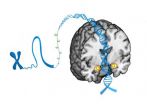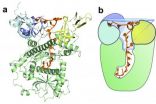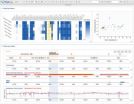(Press-News.org) DURHAM, N.C. -- The tiny addition of a chemical mark atop a gene that is well known for its involvement in clinical depression and posttraumatic stress disorder can affect the way a person's brain responds to threats, according to a new study by Duke University researchers.
The results, which appear online August 3 in Nature Neuroscience, go beyond genetics to help explain why some individuals may be more vulnerable than others to stress and stress-related psychiatric disorders.
The study focused on the serotonin transporter, a molecule that regulates the amount of serotonin signaling between brain cells and is a major target for treatment of depression and mood disorders. In the 1990s, scientists discovered that differences in the DNA sequence of the serotonin transporter gene seemed to give some individuals exaggerated responses to stress, including the development of depression.
Sitting on top of the serotonin transporter's DNA (and studding the entire genome), are chemical marks called methyl groups that help regulate where and when a gene is active, or expressed. DNA methylation is one form of epigenetic modification being studied by scientists trying to understand how the same genetic code can produce so many different cells and tissues as well as differences between individuals as closely related as twins.
In looking for methylation differences, "we decided to start with the serotonin transporter because we know a lot about it biologically, pharmacologically, behaviorally, and it's one of the best characterized genes in neuroscience," said senior author Ahmad Hariri, a professor of psychology and neuroscience and member of the Duke Institute for Brain Sciences.
"If we're going to make claims about the importance of epigenetics in the human brain, we wanted to start with a gene that we have a fairly good understanding of," Hariri said.
This work is part of the ongoing Duke Neurogenetics Study (DNS), a comprehensive study linking genes, brain activity and other biological markers to risk for mental illness in young adults.
The group performed non-invasive brain imaging in the first 80 college-aged participants of the DNS, showing them pictures of angry or fearful faces and watching the responses of a deep brain region called the amygdala, which helps shape our behavioral and biological responses to threat and stress.
The team also measured the amount of methylation on serotonin transporter DNA isolated from the participants' saliva, in collaboration with Karestan Koenen at Columbia University's Mailman School of Public Health in New York.
The greater the methylation of an individual's serotonin transporter gene, the greater the reactivity of the amygdala, the study found. Increased amygdala reactivity may in turn contribute to an exaggerated stress response and vulnerability to stress-related disorders.
To the group's surprise, even small methylation variations between individuals were sufficient to create differences between individuals' amygdala reactivity, said lead author Yuliya Nikolova, a graduate student in Hariri's group. The amount of methylation was a better predictor of amygdala activity than DNA sequence variation, which had previously been associated with risk for depression and anxiety.
The team was excited about the discovery but also cautious, Hariri said, because there have been many findings in genetics that were never replicated.
That's why they jumped at the chance to look for the same pattern in a different set of participants, this time in the Teen Alcohol Outcomes Study (TAOS) at the University of Texas Health Science Center at San Antonio.
Working with TAOS director, Douglas Williamson, the group again measured amygdala reactivity to angry and fearful faces as well as methylation of the serotonin transporter gene isolated from blood in 96 adolescents between 11 and 15 years old. The analyses revealed an even stronger link between methylation and amygdala reactivity.
"Now over 10 percent of the differences in amygdala function mapped onto these small differences in methylation," Hariri said. The DNS study had found just under 7 percent.
Taking the study one step further, the group also analyzed patterns of methylation in the brains of dead people in collaboration with Etienne Sibille at the University of Pittsburgh, now at the Centre for Addiction and Mental Health in Toronto.
Once again, they saw that methylation of a single spot in the serotonin transporter gene was associated with lower levels of serotonin transporter expression in the amygdala.
"That's when we thought, 'Alright, this is pretty awesome,'" Hariri said.
Hariri said the work reveals a compelling mechanistic link: Higher methylation is generally associated with less reading of the gene, and that's what they saw. He said methylation dampens expression of the gene, which then affects amygdala reactivity, presumably by altering serotonin signaling.
The researchers would now like to see how methylation of this specific bit of DNA affects the brain. In particular, this region of the gene might serve as a landing place for cellular machinery that binds to the DNA and reads it, Nikolova said.
The group also plans to look at methylation patterns of other genes in the serotonin system that may contribute to the brain's response to threatening stimuli.
The fact that serotonin transporter methylation patterns were similar in saliva, blood and brain also suggests that these patterns may be passed down through generations rather than acquired by individuals based on their own experiences.
Hariri said he hopes that other researchers looking for biomarkers of mental illness will begin to consider methylation above and beyond DNA sequence-based variation and across different tissues.
INFORMATION:
The study was supported by Duke University, the National Institute on Drug Abuse (DA03369, DA031579), the National Institute on Alcohol Abuse and Alcoholism (AA016274) the Dielmann Family, a Howard Hughes Medical Institute International Student Research fellowship, and the National Institute of Mental Health (MH078928, MH093612, MH084060, MH077159).
CITATION: " Beyond genotype: serotonin transporter epigenetic modification predicts human brain function," Yuliya S. Nikolova, Karestan C. Koenen, Sandro Galea,
Chiou-Miin Wang, Marianne L. Seney, Etienne Sibille, Douglas E. Williamson and Ahmad R. Hariri. Nature Neuroscience, August 3, 2014. doi:10.1038/nn.3778
Small DNA modifications predict brain's threat response
Epigenetic control of serotonin transporter makes difference
2014-08-03
ELSE PRESS RELEASES FROM THIS DATE:
Knowing what to keep and what to trash: How an enzyme distinguishes cellular messages
2014-08-03
Cold Spring Harbor, NY – Every once in a while, we are forced to sort that stack of papers on the kitchen counter. Interspersed between the expired coupons and dozens of takeout menus are important documents like your car insurance or electric bill. So it isn't an option to simply drop it all in the trash at once – you need to read through the messages to be sure that you don't lose vital information.
In the cell, proteins similarly read through messages to distinguish what needs to be saved and what needs to be discarded. But, here, the process takes on a much more ...
Atlantic origin of recent Pacific trade wind, sea level and temperature trends
2014-08-03
An Australian–US team of climate researchers has solved a puzzle that has challenged scientists for over a decade. Climate models predict that the equatorial Pacific trades should weaken with increasing greenhouse gases. Yet, since the early 1990s, satellites and climate stations reveal a rapid and unprecedented strengthening of the Pacific trade winds, accelerating sea level rise in the western Pacific and impacting both Pacific and global climate.
"The answer to the puzzle is that recent rapid Atlantic Ocean warming has affected climate in the Pacific," say the scientists. ...
Self-assembling anti-cancer molecules created in minutes
2014-08-03
Researchers have developed a simple and versatile method for making artificial anti-cancer molecules that mimic the properties of one of the body's natural defence systems.
The chemists, led by Professor Peter Scott at the University of Warwick, UK, have been able to produce molecules that have a similar structure to peptides which are naturally produced in the body to fight cancer and infection.
Published in Nature Chemistry, the molecules produced in the research have proved effective against colon cancer cells in laboratory tests, in collaboration with Roger Phillips ...
Study finds new genetic risk markers in pancreatic cancer
2014-08-03
BOSTON –– A large DNA analysis of people with and without pancreatic cancer has identified several new genetic markers that signal increased risk of developing the highly lethal disease, report scientists from Dana-Farber Cancer Institute.
The markers are variations in the inherited DNA code at particular locations along chromosomes. Several of these variations in the DNA code were identified that influence an individual's risk for pancreatic cancer.
The discovery of these markers – along with four that were previously identified is important for several reasons, said ...
Rare developmental disorder linked to tumor-suppressing protein, Stanford researchers find
2014-08-03
CHARGE, which affects 1 in 10,000 babies, is an acronym whose letters stand for some of the more common symptoms of the condition: coloboma of the eye, heart defects, atresia of the choanae, retardation of growth and/or development, genital and/or urinary abnormalities, and ear abnormalities and deafness.
Originally, the researchers were examining the tumor-suppressive properties of the protein, called p53, not investigating developmental disorders. But when a mouse model developed a strange set of deficiencies, the researchers followed a trail of clues that led them ...
UMD researchers develop tool to better visualize, analyze human genomic data
2014-08-03
Scientists at the University of Maryland have developed a new, web-based tool that enables researchers to quickly and easily visualize and compare large amounts of genomic information resulting from high-throughput sequencing experiments. The free tool, called Epiviz, was described in a paper published online on August 3, 2014 in the journal Nature Methods.
Next-generation sequencing has revolutionized functional genomics. These techniques are key to understanding the molecular mechanisms underlying cell function in healthy and diseased individuals and the development ...
Making sense of scents
2014-08-03
For many animals, making sense of the clutter of sensory stimuli is often a matter or literal life or death.
Exactly how animals separate objects of interest, such as food sources or the scent of predators, from background information, however, remains largely unknown. Even the extent to which animals can make such distinctions, and how differences between scents might affect the process were largely a mystery – until now.
A new study, described in an August 3 paper in Nature Neuroscience, a team of researchers led by Venkatesh Murthy, Professor of Molecular and Cellular ...
Clues to curbing obesity found in neuronal 'sweet spot'
2014-08-02
New Haven, Conn. -- Preventing weight gain, obesity, and ultimately diabetes could be as simple as keeping a nuclear receptor from being activated in a small part of the brain, according to a new study by Yale School of Medicine researchers.
Published in the Aug. 1 issue of The Journal of Clinical Investigation (JCI), the study showed that when the researchers blocked the effects of the nuclear receptor PPARgamma in a small number of brain cells in mice, the animals ate less and became resistant to a high-fat diet.
“These animals ate fat and sugar, and did not gain ...
Pepper and halt: Spicy chemical may inhibit gut tumors
2014-08-02
Researchers at the University of California, San Diego School of Medicine report that dietary capsaicin – the active ingredient in chili peppers – produces chronic activation of a receptor on cells lining the intestines of mice, triggering a reaction that ultimately reduces the risk of colorectal tumors.
The findings are published in the August 1, 2014 issue of The Journal of Clinical Investigation.
The receptor or ion channel, called TRPV1, was originally discovered in sensory neurons, where it acts as a sentinel for heat, acidity and spicy chemicals in the environment. ...
Study reveals one reason brain tumors are more common in men
2014-08-02
New research at Washington University School of Medicine in St. Louis helps explain why brain tumors occur more often in males and frequently are more harmful than similar tumors in females. For example, glioblastomas, the most common malignant brain tumors, are diagnosed twice as often in males, who suffer greater cognitive impairments than females and do not survive as long.
The researchers found that retinoblastoma protein (RB), a protein known to reduce cancer risk, is significantly less active in male brain cells than in female brain cells.
The study appears Aug. ...
LAST 30 PRESS RELEASES:
Tracing the quick synthesis of an industrially important catalyst
New software sheds light on cancer’s hidden genetic networks
UT Health San Antonio awarded $3 million in CPRIT grants to bolster cancer research and prevention efforts in South Texas
Third symposium spotlights global challenge of new contaminants in China’s fight against pollution
From straw to soil harmony: International team reveals how biochar supercharges carbon-smart farming
Myeloma: How AI is redrawing the map of cancer care
Manhattan E. Charurat, Ph.D., MHS invested as the Homer and Martha Gudelsky Distinguished Professor in Medicine at the University of Maryland School of Medicine
Insilico Medicine’s Pharma.AI Q4 Winter Launch Recap: Revolutionizing drug discovery with cutting-edge AI innovations, accelerating the path to pharmaceutical superintelligence
Nanoplastics have diet-dependent impacts on digestive system health
Brain neuron death occurs throughout life and increases with age, a natural human protein drug may halt neuron death in Alzheimer’s disease
SPIE and CLP announce the recipients of the 2025 Advanced Photonics Young Innovator Award
Lessons from the Caldor Fire’s Christmas Valley ‘Miracle’
Ant societies rose by trading individual protection for collective power
Research reveals how ancient viral DNA shapes early embryonic development
A molecular gatekeeper that controls protein synthesis
New ‘cloaking device’ concept to shield sensitive tech from magnetic fields
Researchers show impact of mountain building and climate change on alpine biodiversity
Study models the transition from Neanderthals to modern humans in Europe
University of Phoenix College of Doctoral Studies releases white paper on AI-driven skilling to reduce burnout and restore worker autonomy
AIs fail at the game of visual “telephone”
The levers for a sustainable food system
Potential changes in US homelessness by ending federal support for housing first programs
Vulnerability of large language models to prompt injection when providing medical advice
Researchers develop new system for high-energy-density, long-life, multi-electron transfer bromine-based flow batteries
Ending federal support for housing first programs could increase U.S. homelessness by 5% in one year, new JAMA study finds
New research uncovers molecular ‘safety switch’ shielding cancers from immune attack
Bacteria resisting viral infection can still sink carbon to ocean floor
Younger biological age may increase depression risk in older women during COVID-19
Bharat Innovates 2026 National Basecamp Showcases India’s Most Promising Deep-Tech Ventures
Here’s what determines whether your income level rises or falls
[Press-News.org] Small DNA modifications predict brain's threat responseEpigenetic control of serotonin transporter makes difference







